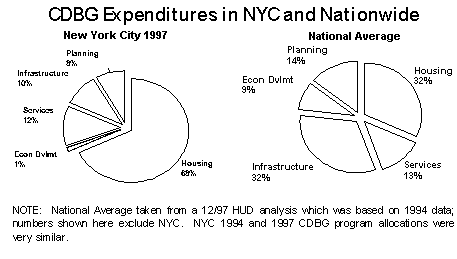
On April 1, 1998, the City of New York released its calendar year 1997 Community Development Block Grant (CDBG) Performance Report which highlights how the city spent $257 million in CDBG funds. IBO's analysis of the performance report shows that the city's use of the grant differs significantly from the rest of the nation.
The CDBG program was established by Congress to revitalize neighborhoods and promote economic development. Communities are allowed to develop their own program priorities but precedence must be given to activities which benefit low- and moderate-income people. In New York City, CDBG funds support activities at 19 city agencies and authorities and account for 6 percent of the city's federal categorical aid (revenues restricted to certain programmatic uses).
IBO's analysis of the city's 1997 CDBG expenditures shows that $175 million, or 68 percent of its total, was spent on housing rehabilitation and maintenance. Expenditures on public services, such as providing security at homeless shelters, accounted for 12 percent of the total followed by investments in public facilities and infrastructure-including a vacant lot cleanup program-at 10 percent, and planning and administration activities at 8 percent. About 1 percent was spent on economic development initiatives.
According to data from the U.S. Department of Housing and Urban Development (HUD), the use of CDBG funds nationwide varies greatly from NYC's profile. HUD's latest U.S. comparison, which examines $3 billion in 1994 CDBG expenditures, shows that nationwide, CDBG funds are distributed more evenly over program areas than in NYC. As shown below, municipalities (excluding New York City) on average spent 32 percent of their grants on housing rehabilitation and maintenance, 32 percent on public facilities and infrastructure repairs, 14 percent on planning and administration, 13 percent on public services, and 9 percent on economic development activities.
The disparity between New York City and national CDBG expenditures highlights the fact that the city has a disproportionately large stock of in rem housing units-city-owned properties acquired when the prior owner became delinquent on tax payments. By imposing a moratorium on acquiring new in rem properties and by implementing several initiatives to sell the existing stock of in rem units to third parties, the current administration has decreased the number of in rem units by 45 percent over the last five years. This trend is expected to continue and should eventually allow some of the CDBG funds now used for housing rehabilitation and maintenance to be dedicated to other purposes. For copies of a recently released IBO budget fax on the CDBG program please visit the Publications section of the website or call IBO at (212) 442-0632.
